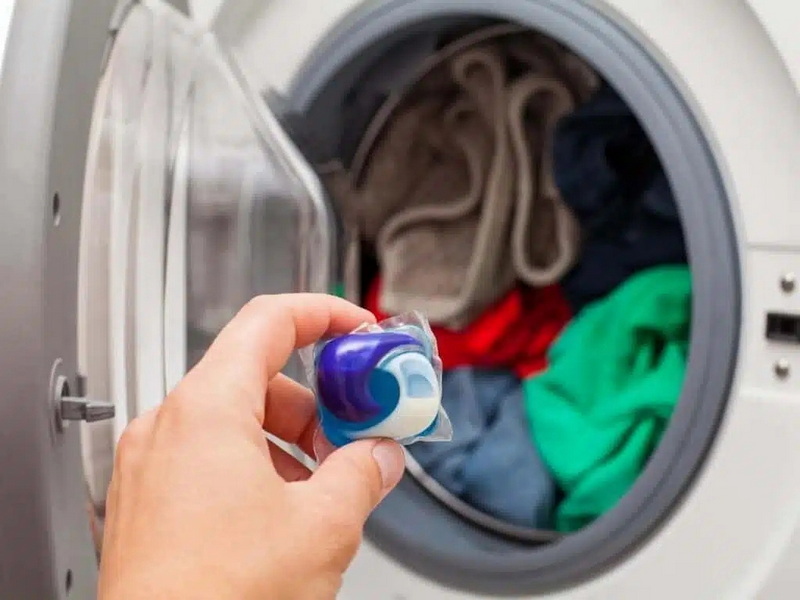Dongguan UFine Daily Chemical Co.,Ltd.
- All
- Product Name
- Product Keyword
- Product Model
- Product Summary
- Product Description
- Multi Field Search
Views: 222 Author: Tomorrow Publish Time: 10-19-2025 Origin: Site











Content Menu
● Why Do Laundry Pods Not Melt Prematurely?
>> Stability of the Polyvinyl Alcohol Film
>> Relationship Between Film and Detergent
● The Science Behind the Polyvinyl Alcohol (PVA) Film
● How Laundry Pods Are Tested for Stability
● Safety Features Related to Pod Stability
● Environmental and Usage Considerations
● Innovations in Laundry Pod Technology
● Frequently Asked Questions (FAQ)
>> 1. What material is used for the outer film of laundry pods?
>> 2. Why don't pods dissolve in the bottle with liquid detergent?
>> 3. Can laundry pods melt if stored in humid conditions?
>> 4. How fast do laundry pods dissolve once added to the wash?
>> 5. Are laundry pods environmentally friendly?
Laundry pods have revolutionized the way people do laundry by offering a convenient and mess-free solution for cleaning clothes. These pre-measured detergent packets seem sturdy and intact before use, but what prevents them from melting or breaking down prematurely despite containing liquid soap inside? This article explores the science and engineering behind laundry pods, examining their composition, materials, and the mechanisms that keep them stable until they dissolve in water during a wash cycle.

Laundry pods, also called detergent pods or capsules, are compact packets containing detergent, stain removers, and sometimes fabric softeners. They are designed for single-use and dissolve in water to release cleaning agents. Unlike traditional liquid or powder detergents, pods combine convenience, precise dosing, and minimal waste. The pods are popular because they reduce the mess of spilling detergent, minimize overdosing, and simplify laundry routines.
The liquid detergent in pods contains surfactants, enzymes, fragrances, and other cleaning agents. These components are formulated to be concentrated and effective in removing stains and dirt. The detergent is typically a mix of water, cleaning chemicals, and sometimes solvents for stain removal. Its consistency is carefully controlled to remain liquid but stable within the capsule.
The outer shell of a laundry pod is made of a water-soluble film, commonly polyvinyl alcohol (PVA). This polymer film is key to the pod's function: it remains solid and sealed until the pod is exposed to water during a wash. The film forms a thin, transparent barrier that encases the detergent safely and securely.
PVA is soluble in water but not in non-polar solvents or oils. Since the detergent inside is largely aqueous and the pod is stored in dry conditions, the PVA film remains intact. It only dissolves when in contact with water, which is the washing machine environment. The molecular structure of PVA ensures strong hydrogen bonding that leads to good mechanical strength and chemical resistance.
The detergent inside and the film have limited chemical interaction under dry storage conditions. The pod encapsulation protects the liquid detergent from leaking and prevents the film from breaking down through interaction with the contents inside. The detergent formula is also designed to be compatible with PVA, avoiding ingredients that could weaken or dissolve the film prematurely.
Laundry pods must be kept dry. Exposure to humidity or water can begin dissolving the film prematurely, so packaging often includes moisture barriers such as sealed plastic containers or foil-lined boxes. This ensures pods remain stable until use. Consumers are advised to store pods in airtight containers and in low-humidity areas.

PVA is a synthetic polymer formed by polymerizing vinyl acetate and then hydrolyzing it to produce a water-soluble polymer. Its strong hydrogen bonding makes it stable and resistant to many chemicals except water. The polymer chains align to provide mechanical strength and flexibility, enabling the film to maintain integrity over time.
The film dissolves at specific temperatures and water volumes, typically when introduced to warm or hot water in washing machines. This allows controlled release of detergent substances. PVA's solubility parameters can be adjusted by altering the degree of hydrolysis or polymer chain length, tailoring how quickly the pod dissolves.
The PVA film is engineered to be flexible and strong enough to hold liquid detergent without tearing during handling but will quickly dissolve in water. Its thickness is optimized to balance durability with dissolution speed. Additionally, plasticizers may be used to improve flexibility and resilience against mechanical stress.
Manufacturers conduct extensive tests to ensure pods maintain integrity under various conditions:
- Humidity Testing: Pods are placed in controlled humidity chambers to observe if the PVA film begins to soften or dissolve at different moisture levels, replicating real-world storage conditions.
- Leakage Tests: Pods undergo mechanical stress simulation such as shaking and compressing to verify that detergent does not leak during shipping or handling.
- Dissolution Testing: Pods are immersed in water of varying temperatures and cycles to ensure they fully dissolve within the expected timeframe during wash.
- Shelf-life Testing: Long-term storage studies confirm that pods do not degrade or lose performance over months or years.
Laundry pods must be stable not only for convenience but also to prevent accidental exposure or poisoning, especially in households with children or pets. The film's resistance to moisture in handling environments mitigates risks until pods are intentionally dissolved. Some manufacturers add bittering agents or warnings on the packaging to discourage ingestion but maintaining the physical integrity of pods is the first safety line.
PVA films used in pods are increasingly designed to biodegrade after use, breaking down into non-toxic compounds in water and soil. This helps reduce environmental pollution compared to conventional plastic packaging. However, the biodegradability depends on wastewater treatment and environmental conditions.
Users are advised to keep pods in sealed containers away from moisture and children to prolong pod stability and ensure safety. Storing pods in dry places like bathroom cabinets or laundry rooms with good ventilation is recommended to avoid early dissolving or clumping.
Laundry pods reduce detergent waste by delivering precise doses, which helps to minimize excess chemical release into the environment. Their compact size also reduces packaging volume and transportation emissions.
Research continues to improve pod films to dissolve faster, enable multi-chamber pods that separate incompatible ingredients, and use more environmentally friendly materials while maintaining stability during storage. Some companies explore plant-based polymers or enhanced formulations for even safer and biodegradable films. Advances in pod design also focus on making pods easier to use while maintaining child-resistance and minimizing accidental punctures.
Laundry pods stay solid and do not melt from the soap inside primarily due to the unique properties of the polyvinyl alcohol film that encases the liquid detergent. This water-soluble film is carefully engineered to remain stable and impermeable under dry conditions, preventing any interaction with the liquid soap that could cause premature melting. Only when introduced to water during the wash cycle does the film dissolve, releasing the detergent effectively. Proper packaging, storage, and ongoing material advancements all contribute to the pods' reliability and convenience. As technology advances, laundry pods continue to evolve with improved safety, environmental responsibility, and user experience.

The outer film is typically made from polyvinyl alcohol (PVA), a water-soluble synthetic polymer engineered to dissolve only when exposed to water.
Pods do not dissolve in liquid detergent because PVA film is insoluble in non-water solvents like oils or other detergent components and requires water to dissolve.
Yes, exposure to humidity can cause the PVA film to begin dissolving prematurely, so pods must be stored in dry, moisture-controlled environments.
Pod dissolution usually occurs within minutes in warm or hot water, releasing the detergent efficiently during the wash cycle.
Modern pods often use biodegradable PVA films and concentrated detergents to reduce packaging waste, but environmental impact depends on usage and disposal practices.